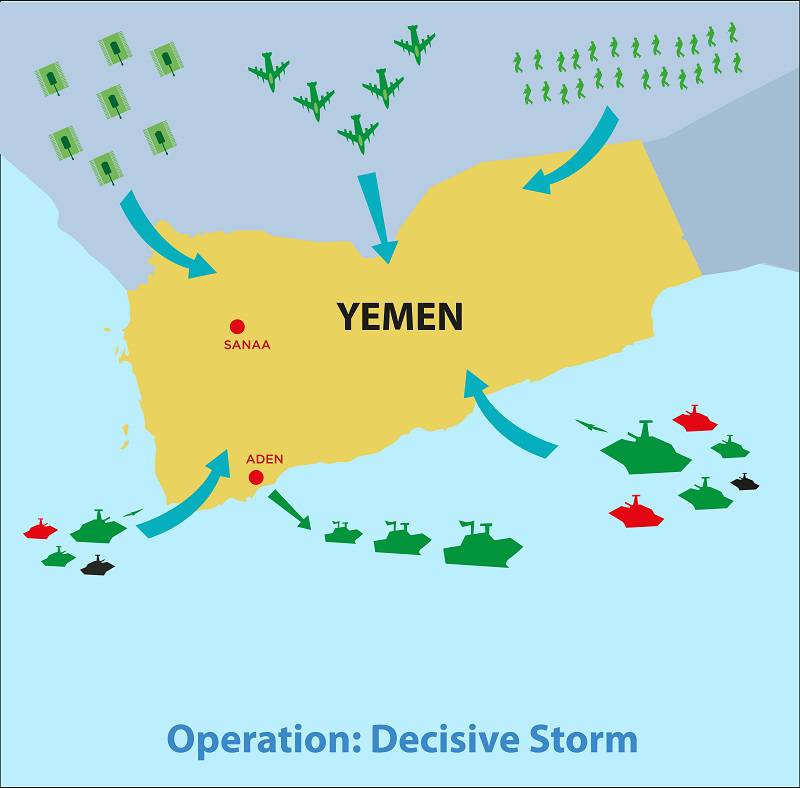A domestic rebellion in Yemen has devolved into a sectarian security threat to the entire Arabian Peninsula.
What started out in 2004 as an internal conflict between the Houthis — a Shiite rebel movement — and the Yemeni government seems to have devolved into an ideological and geopolitical war involving both internal and external forces.
So much has been written about Saudi Arabia and Iran’s hegemonic pursuits in the Middle East. Neglected in many analyses, however, is a fair assessment of how internal (socioeconomic, historical and ideological) as well as external factors (geopolitical praxis exerted by key regional players) have given rise to a wider regional conflagration that threatens the peace and security of the entire region.
As Egypt and Saudi Arabia mull over plans to send ground troops into Yemen, one wonders about the denouement of Riyadh’s intervention against the backdrop of Iran’s ascendance; whether al-Qaeda and violent extremism will ultimately devour the Arabian Peninsula, or if a semblance of order will be restored.
Almost six years before the advent of the Arab Spring in 2010, a ragtag of disgruntled student activists led by Hussein al-Houthi — a radical cleric who hoped to “promote a Zaidi revival” in the northwestern province of Saada — staged a putsch against the government of then-Yemeni President Ali Abdullah Saleh. Although, Houthi himself was killed following months of skirmishes between Yemeni security forces and Zaidi Shiite rebels, the northerners’ pent-up antipathy toward the Saleh regime and his divide-and-rule system of governance never subsided.
For whatever reason — be it Saleh’s endorsement of the Iraq War in 2003, balancing the rising influence of Salafism in the northern highlands or due to their chronic sense of disenfranchisement — the Houthi rebels, better known as Ansar Allah, pressed ahead with their never-ending demands for greater autonomy. They spearheaded another five rebellions before a flimsy ceasefire was reached between the rebels and the government in 2010. A year prior to the ceasefire, however, Yemen saw for the first time since 1991 a military incursion initiated by the Saudis inside the northern parts of the country; although it culminated in an embarrassing defeat for Riyadh and Saleh loyalists.
Meanwhile, in the south — where the populace had grown weary of the Yemeni government’s alleged unequal distribution of land and resources, and of Saleh’s inability to address unemployment, political marginalization and insecurity — the Southern Separatist Movement, better known as Hirak, entered the fray. This movement called for splitting Yemen, a country of 24 million people and one of the poorest in the Arab world, down pre-unification lines.
According to the World Bank, aside from the continued scourge of poverty in Yemen, approximately 45% of the population is food insecure and the country’s scarce water resources are far below the regional average. Added to this cataclysmic turn of events, an ever-present terrorist threat is posed by al-Qaeda in the Arabian Peninsula (AQAP) and its local affiliate, Ansar al-Sharia, who have taken large swathes of territory in the restive south.
The Arab Spring
In 2011, the air in the Middle East and North Africa was thick with the sense of fear and fin de régime. As the Arab dictators of Tunisia and Egypt fell like dominoes during the Arab Spring, a whiff of wind was more than enough to push large sections of Yemeni society out onto the streets of Sana’a, where the youth and civil society activists demanded an end to Saleh’s 33-year rule. For this to happen, a gaggle of unlikely bedfellows came together to form a revolutionary front. It was in this amorphous and loosely organized coalition, which Houthis were a part of along with the main opposition bloc, the Joint Meeting Parties (JMP), that the Zaidi Shiite movement found a unique opportunity to further augment its bargaining power vis-à-vis its rival factions and government-aligned forces in the face of a potential power vacuum created by regime change in Yemen.
In early 2012, Saleh relinquished power as part of a transition road map devised by a Gulf Cooperation Council (GCC) initiative, and he agreed to legally hand over power to his deputy, Abd Rabbuh Mansour Hadi, in exchange for domestic immunity from prosecution.
Consequently, a National Dialogue Conference (NDC) was patched together to deliberate over myriads of longstanding challenges and ultimately produce a new constitution. Although the conference concluded in January 2014 with the promise of federalization — which is carving out the country into six regions — it became increasingly evident that neither the Houthis, nor the separatist Southern Movement had reached a solid consensus within themselves and with each other to fully implement and comply with the provisions of the GCC initiative. In fact, to northerners a united southern federal state would give the southerners full access to Yemen’s largest oil reserves, whereas to many of Hirak’s representatives, who were grappling with internal differences at the time of negotiations, independence was considered to be the only viable option.
The Houthi Surge
In this setting, and in the absence of a fully-fledged military apparatus and state security services in many areas of the country, a whole host of state forces, armed non-state actors and external regional players seem to have stepped up to the plate in a bid to fill the security void.
Most importantly, though, things took a turn for the worst in September 2014, when the Houthi rebels attacked the Yemeni capital, Sana’a, and then put President Hadi under house arrest. Hadi, who resigned in January 2015, fled to Aden in February and subsequently escaped to Riyadh in March as Houthi forces took control of large parts of Sana’a.
The Saudis, however, were quick to respond to the siege of Sana’a and Hadi’s forcible removal from office. They used the same tactic that had previously been implemented in response to Bahrain’s pro-democracy uprising in 2011. Backed by American intelligence and supplied with advanced US-made weaponry, Saudi Arabia, along with its allies, launched massive airstrikes in March against Houthi strongholds in Yemen under the rubric of “restoring the legitimate government.”
At this juncture, it is far from certain whether the Saudi military’s intervention will successfully catapult Hadi back into the Republican Palace. But one thing is deemed irrefutable: Owing to the confluence of several factors previously discussed, a domestic rebellion has devolved into a sectarian security threat to the entire Arabian Peninsula, where insurgents affiliated with the Islamic State have set their sights on the whole region.
It is in this context that the geopolitical narratives come to the fore, as the civil war in Yemen is now largely portrayed as a proxy battle between the Middle East’s Sunni powers and Shiite-dominated Iran. In fact, both Riyadh and Hadi have denounced the Shiite Houthi rebels as the “stooges of Iran.” This brings us to the question: Is the raging pandemonium in Yemen a classic example of geopolitical maneuvering at play, and to what extent is this conflict a corollary of realpolitik reasoning on the part of regional stakeholders in the first place?
Iran-Saudi Arabia Nexus: A Geopolitical Turn
Tensions were further complicated on January 23 as a result of the interception and subsequent seizing of what officials in Yemen described as an “Iranian vessel trying to smuggle explosives and surface-to-air missiles to the country,” a claim denied by Tehran. Although there is no substantive evidence to corroborate these allegations — with the United Nations Monitoring Group reportedly saying that the ship could have been intended for Somalia — the discourse of Iranian officials since the onset of the Yemeni uprising have provided Sunni petro-monarchies of the GCC with ample ammunition to project Tehran’s rhetoric as feeding into the Sunni-Shiite divide in the Middle East, and to portray its moves as blatant encroachment onto the Saudi sphere of influence.
Having said that, it is interesting to note that less than a week into the ship incident, the former speaker of Iran’s parliament, Ali Akbar Nategh-Nouri, referred to Yemen as Iran’s new sphere of influence, adding: “We witness today that our revolution is exported to Yemen, Syria, Lebanon and Iraq.” At around the same time, the head of Iran’s Revolutionary Guard Corps, Lieutenant Gen. Hossein Salami, struck a similar tone, saying: “Ansarollah [Houthis] is a similar copy of Hezbollah in a strategic area.”
But let us juxtapose these comments with a statement from GCC Secretary-General Abdullah Bishara back in 1982, when he said: “Iran’s quest for supremacy in the (Persian) Gulf was the primary threat to the stability of the GCC.” Based on the foregoing, it is quite axiomatic that the fear of Iran’s ascendency in the Middle East has been a recurrent theme in the Saudi Arabia’s foreign policy.
What merits pondering, however, is that Saudi’s Iranophobia and the use of the sectarian card in Yemen came on the heels of two geo-strategically important events which, much to the GCC’s dismay, have shifted the balance of power in favor Iran. The first is the perceived US-Iran détente and the recent announcement of the tentative agreement between Iran and the P5+1. The second pivotal trend pertains to the perceived expansionism and the “spatializing” of Iran’s foreign policy, as evidenced by the increase in the power and influence of Tehran in shaping regional trends and security preferences in Syria, Lebanon and Iraq, a move viewed by the GCC as an offensive power.
In fact, if we assume, as Stephen Walt does, that states attempt to prevent a potential hegemon by balancing and forming alliances against the perceived threat, then it would be justifiable to assert that Saudi Arabia’s intervention in Yemen can be best explained through the lens of the balance of threat theory in international relations.
The contention, therefore, is that Yemen has become the epicenter of the Saudi-Iranian geopolitical collision as Iran, Iraq, Lebanon and Syria are seen as opposing the Salafist order, whereas the GCC aims to stifle the spread of the so-called Shiite Crescent extending from Beirut to the Persian Gulf.
Feeding into the Extremist Narrative?
Keeping these premises in mind, an intriguing question arises as to what really makes the Saudi and Iranian vying for domination different from the former instances of jockeying for power and influence in Yemen’s history.
It is needless to say that such adventures and occupations are not alien to Yemenis: The British capture of Aden in 1839 aimed at staving off the Egyptian conquest of the entire Arabian Peninsula, while Egyptian President Gamal Abdel Nasser set out to export pan-Arabism across Yemen during the 1960s.
But today’s Yemeni conflict proves to be a sui generis case, in that it threatens to open the floodgates of an ideological warfare in the Arabian Peninsula; one that does not only pit the Zaidis against the Salafists, but the kind of which that may put the final nail in the coffin of dialogue and ultimately secure a Pyrrhic victory for the Islamic State and the discourse of extremism.
Further to this, one should not lose sight of the fact that the Yemen crisis was first and foremost a sociopolitical and domestic problem, which was not addressed properly by Saleh and the corrupt state apparatus he left behind. What Yemen suffers from is somewhat a corollary of manufacturing an ill-functioning regime, whose main constitutive elements were repression, megalomania and corruption. Yemen’s weakness in surmounting a multiplicity of home-grown challenges set the stage for major regional actors to readjust their security alliances and carve out their own niche of influence in the hitherto divided country.
Saleh used to claim boastfully that ruling Yemen was “like dancing on the heads of snakes.” It was only a matter of time before he noticed that the Islamic State is silently snaking through the streets of Sana’a and valleys of the southern cities.
The views expressed in this article are the author’s own and do not necessarily reflect Fair Observer’s editorial policy.
Photo Credit: Dmitry Chulov / Crystal Eye Studio / Fedor Selivanov / Esfera / Shutterstock.com
 We bring you perspectives from around the world. Help us to inform and educate. Your donation is tax-deductible. Join over 400 people to become a donor or you could choose to be a sponsor.
We bring you perspectives from around the world. Help us to inform and educate. Your donation is tax-deductible. Join over 400 people to become a donor or you could choose to be a sponsor.
Support Fair Observer
We rely on your support for our independence, diversity and quality.
For more than 10 years, Fair Observer has been free, fair and independent. No billionaire owns us, no advertisers control us. We are a reader-supported nonprofit. Unlike many other publications, we keep our content free for readers regardless of where they live or whether they can afford to pay. We have no paywalls and no ads.
In the post-truth era of fake news, echo chambers and filter bubbles, we publish a plurality of perspectives from around the world. Anyone can publish with us, but everyone goes through a rigorous editorial process. So, you get fact-checked, well-reasoned content instead of noise.
We publish 2,500+ voices from 90+ countries. We also conduct education and training programs
on subjects ranging from digital media and journalism to writing and critical thinking. This
doesn’t come cheap. Servers, editors, trainers and web developers cost
money.
Please consider supporting us on a regular basis as a recurring donor or a
sustaining member.
Will you support FO’s journalism?
We rely on your support for our independence, diversity and quality.










Comment